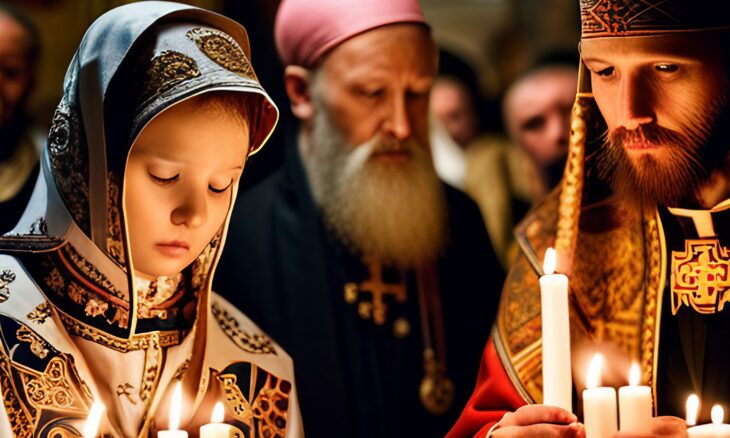The Power of Liturgy in Orthodox Christian Prayer
The prayer tradition of Orthodox Christians is deeply rooted in the communal liturgy rather than confined to individual devotion or monastic seclusion. Liturgy serves as both the source and the rhythmic framework for adoration and intercession. While distinct from prayer itself, liturgy provides the regular expression and pattern for prayer in every aspect of life. From the weekly cycle of services to the daily routine of morning and evening prayer, Orthodox Christians find that liturgy spills over into their daily lives, infusing them with spiritual vitality.
Prayer as a Mirror of the Inner Life
Prayer serves as the touchstone of a person’s spiritual journey, revealing the depth and authenticity of their relationship with God and others. It is through prayer that we learn how to communicate and relate to our fellow human beings. Whether one has dedicated their life to continuous prayer as a monastic or is a layperson engaging with the world, prayer plays a central role in their spiritual formation. It is not a privilege reserved for a select few but a calling for all individuals. In its essence, prayer reflects the universal human connection to God, others, and the natural world.
Prayer as Personal Experience and Sacramental Encounter
While there are various methods and approaches to prayer, it cannot be approached as a detached observation or mere external practice. Prayer must be personally lived and intimately experienced. As Saint John Climacus emphasizes in his Ladder of Divine Ascent, prayer is not learned from manuals or books; it is a living and dynamic relationship between prayer and God. Prayer is not an abstract concept but a vibrant expression of a burning heart. It is a deeply relational experience that seeks mystical connection and encounters with the divine. To truly understand prayer, one must grasp its inherent connection to others and to God, ensuring that discussions about prayer do not distort its true essence.
The Inclusive Nature of Prayer
Prayer, at its core, is an inclusive practice that embraces the presence of others, encompasses the entire world, and most importantly, welcomes God as the divine “Other.” According to Saint John Climacus, faith in God serves as the wing, proof, and self-verification of prayer. This openness to others should inform our prayers at all times, ensuring that we approach prayer with a broad and inclusive mindset.
The Dialogical Essence of Prayer
Prayer is always a dialogue, a dynamic exchange between the human heart and God, which can be experienced even in moments of silence. However, this silence is not a mere absence of sound; it is a silence that fosters a connection with God. As the Psalmist writes, “Be still, and know that I am God” (Psalm 45:11). This silence in prayer requires active listening, expectant anticipation, and a readiness to hear God’s voice. It is through this receptive silence that prayer becomes a means to engage with what is happening within us and around us, allowing us to cultivate a deeper understanding and connection with the world.
Prayer as Concern for Others and Reconciliation
It is unfortunate that prayer has often been reduced to a private act focused on personal complaints and desires. Genuine prayer, however, calls us to extend our concerns beyond ourselves and to be mindful of the well-being of others, the world, and particularly those who are vulnerable and in need of protection. When prayer becomes exclusive or divisive, it negates its true essence. True prayer reveals a sense of togetherness and reconciliation with all of humanity and creation. The Macarian Homilies emphasize that those who pray truly and in silence edify and uplift everyone, everywhere. Prayer possesses cosmic significance and a universal force in the world, reminding us of the interdependence of all humankind and the profound impact our thoughts, feelings, beliefs, and actions have on the world around us. Love for God cannot exist without love for our neighbors, and authentic prayer encompasses this fundamental truth.
The Essential Purpose of Prayer: Self-Purification
The primary objective of prayer, as emphasized by Evagrius of Pontus, is self-purification. He asserts that before anything else, we must pray to be cleansed from our passions. Without purification, prayer loses its authenticity and becomes nothing more than false piety. The Desert Fathers and Mothers go even further, stating that purity itself is prayer. To truly connect with our Creator and the world around us, we must strip away anything unnecessary or hindering.
The Sequence of Prayer: Thanksgiving, Confession, and Petition
The recommended sequence of prayer, according to the Church Fathers, is thanksgiving, confession, and petition. This order emphasizes the importance of looking outward, focusing on others rather than ourselves. The act of sincere gratitude should precede confession and heartfelt contrition, allowing us to acknowledge our faults and seek forgiveness. Finally, we present our petitions to God. This approach to prayer, revealed by an angel, has been echoed by various spiritual thinkers throughout history, reinforcing the idea that prayer should not revolve solely around our own concerns and desires.
Prayer as a Way of Life, not a Singular Act
In the Orthodox tradition, prayer is not confined to a specific stage or time in the spiritual journey; instead, it is an all-encompassing activity that permeates every aspect of life. Prayer is not meant to be limited to specific moments or occasions; rather, it calls for a holistic integration of our lives with the world. By seeking moments of silence and allowing the needs of the world to rise within us, prayer becomes an integral part of our being. It is not just about reciting prayers, but about embodying prayer in every moment. As Origen of Alexandria eloquently put it, the entire life of a saint is one continuous, unbroken prayer. The ultimate goal is to become living prayers, radiating warmth and comfort to those in despair and need.



